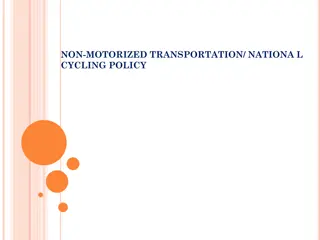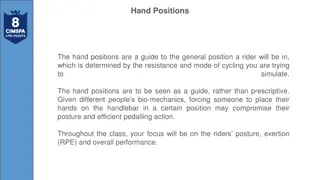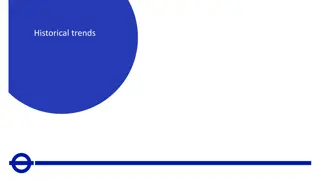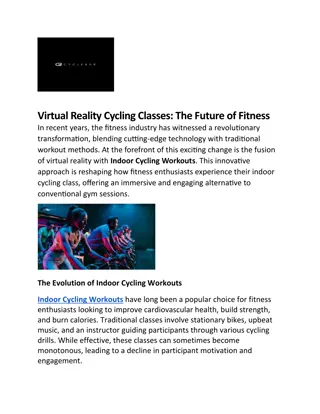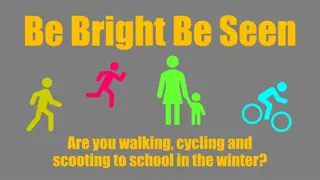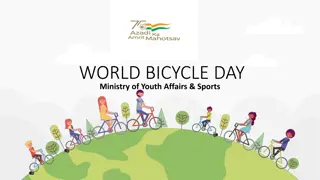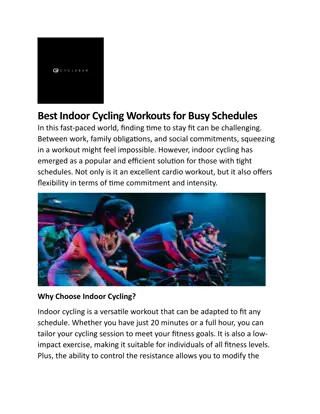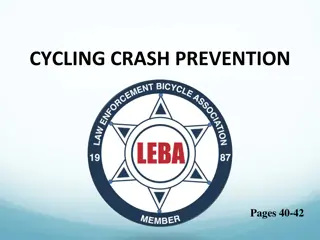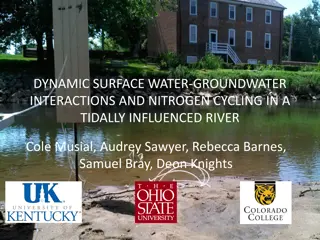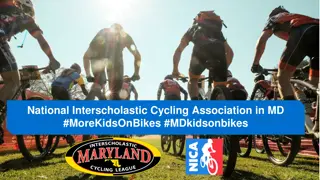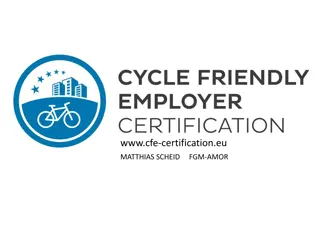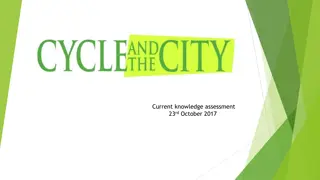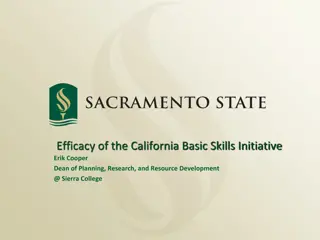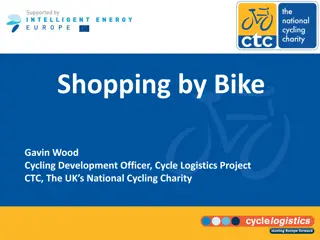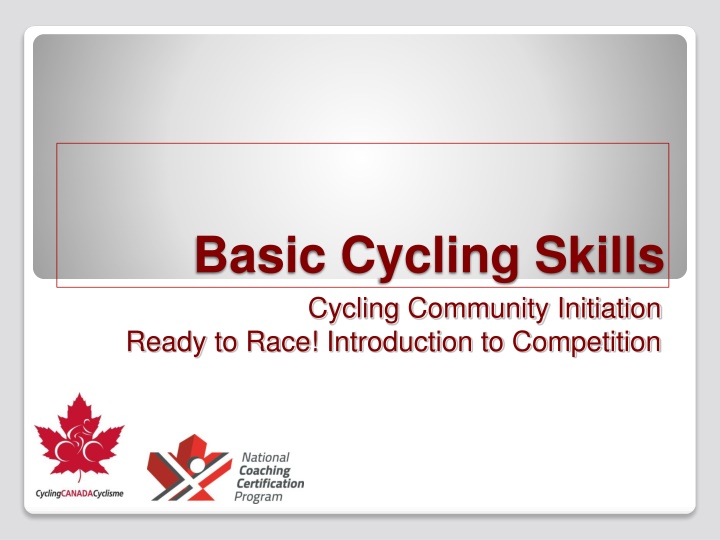
Enhancing Cycling Skills: From Basics to Competition Level
Delve into the world of cycling with a focus on skill acquisition, community initiation, and competition development. Explore pathways to becoming a trained coach, covering fundamental cycling skills, coaching streams, and strategies for readying athletes for race day.
Download Presentation

Please find below an Image/Link to download the presentation.
The content on the website is provided AS IS for your information and personal use only. It may not be sold, licensed, or shared on other websites without obtaining consent from the author. If you encounter any issues during the download, it is possible that the publisher has removed the file from their server.
You are allowed to download the files provided on this website for personal or commercial use, subject to the condition that they are used lawfully. All files are the property of their respective owners.
The content on the website is provided AS IS for your information and personal use only. It may not be sold, licensed, or shared on other websites without obtaining consent from the author.
E N D
Presentation Transcript
Basic Cycling Skills Cycling Community Initiation Ready to Race! Introduction to Competition
NCCP Coaching Streams and Contexts Competition Introduction Instructor Beginner Ready to Race! Community Initiation Let s Ride! Instructor Intermediate Competition Development Performance Cycling Community Ongoing Competition High Performance Instructor Advanced
Lets Ride! Community Initiation Pathway To achieve the status of In-Training a coach must complete: Let s Ride! Community initiation To achieve the status of Trained a coach must complete: Let s Ride! Community initiation Basic Cycling Skills
Ready to Race! Introduction to Competition Pathway To achieve the status of In-Training a coach must complete: Basic Cycling Skills Training Basics To achieve the status of Trained a coach must complete: Skills and Tactics (one discipline) Training to Race Skills and Tactics (a second disciplines) To achieve the status of Certified a coach must complete: : Make Ethical Decisions Online Evaluation- Comp-Int Coach Portfolio Online evaluation for two disciplines
Basic Cycling Skills Skill Acquisition
What is a skill? The ability to perform a movement or chain of movements with high consistency, high precision, and high efficiency
The Challenge Zone Or matching the difficulty of the activity with the skill level of the participant High ANXIETY REQUIRE- MENTS OF THE ACTIVITY BOREDOM Low Low High PARTICIPANT PROFICIENCY LEVEL
ATTENTION BALANCE CONTROL Simple Riding & Coasting PEDAL BRAKE GEAR TURN & CORNER Looking Straight-line Riding Sitting Front Rear INCREASED CHALLENGE Medium Identifying Balanced Position Soft Rear Front The ABCs: Basic Body Movements Fast Reacting Weight Transfer F, R, Side Standing Combined Slow Ready Position Punch Modulate Tight Weighting & Unweighting Ratchet Slippery Narrow-platform Riding Track Stand P.A.S.S. SKILLS - BUILT FROM ABCs POWER AGILITY SPATIAL SENSE CLIMB ACCELERATE DROP LIFT MOUNT & DISMOUNT GROUP TRAFFIC DESCEND Sitting Sitting Rolling Front Follow Laws Sitting INCREASED CHALLENGE Straddle on Standing Standing Huck 2 Wheel Draft Signal Standing P.A.S.S.: Straddle off Crouching Standing start Rear Pass Shoulder check MOVE Cowboy on Integrated Skills Gate start Dolphin Pack Limbo Bails Position Sprinting Manual Bump Pickup & Drop (one hand) Carry Anticipate Side Buzz Safe Fall Wheelie Echelon No hands A CYCLING SKILLS MODEL
3- or 5-Phase Skill? Skills can be analyzed as: 5 Phase: Set-up Preliminary movements Force-producing movements Critical instant Follow-through Example?
3- or 5-Phase Skill? OR, 3 Phase: Set-up Movement Follow-through Example?
3- or 5-Phase Skill? OR, 3 Phase: Set-up Movement Follow-through Example?
Skill analysis task: Choose a cycling skill What is the purpose of the skill? Break the skill down into parts Is it 3- or 5-phase?
Step 7: Equipment and Basic Cycling Position
Step 8: Practice Coaching Session 2
Basic Cycling Skills: Error Detection & Correction
Observation Strategy: If you wanted to observe this skill being done by a beginner, what would the best vantage point be? Where to stand? What to look at? What to watch for? Fill in Observation Strategy box
Outcome / Form of sport task The outcome serves to describe when the skill of tactic is clearly achieved or not achieved 1. Preliminary movements (i.e. Grip / Stance) Back swing or recovery movement (i.e. positioning, back swing, recovery) Force producing movement (i.e. Use or sequence of muscle group and joint action) Critical instant (i.e. impact, strike, ) Follow through. Key Performance Factors How is the outcome achieved? 2. 3. Detectable Signs What is observed? How is it observed? 4. 5.
Detectable Signs What is observed? How is it observed? Participant does not engage in task Participant engages in the task but the outcome is not achieved Participant engages in the task and achieves the outcome or demonstrates form Inconsistencies or inefficiency in movement or task - Little precision or low probability of success in the task Consistent and efficient movements demonstrated in task High degree of precision and probability of success in the task What key factors come into play?
Analyze potential causes CAUSE Select Appropriate Corrective Measure GAP A. Equipment Issue FIT / TUNING 1.Equipment Makes sport specific adjustments to equipment Adjust task demands Modify / Adjust Drill or Activity B. Environmental factor Weather / lighting 2. Environment Repeat task/activity C. Fear or Hesitation 3. Affective Adjust progression D. Not motivated or not interested Adjust speed or timing or intensity E. Lack understanding or player confused 4. Cognitive / Mental Adjust work to rest ratios, and / or Intensity (Workload) F Too much information or information overload G. Lack Concentration or poor arousal control Help or reassure Teaching Interventions H. Difficulty reading / recognizing cues Explains or Ask Questions Simplify - Use examples or reduce variables to process J. Task too Demanding or too easy 5. Physical / Motor I. Lacks physical ability to complete task Use re-focusing or visualization strategies Demonstrate correct technique / tactic K. Unable to select appropriate tactic L. Choice of Decision 6. Tactical Provide feedback or results M. Unable to effectively or consistently execute technique 7. Technical
THE TEACHING PROCESS Organization Can someone else do the demonstration better than me ? Includes safety measures, and how the activity starts and finishes Requires at least 50% motor involvement Coach is able to supervise Explanation/Demonstration Describe the aim of the exercise Outline what is to be done and how Describe points of reference/cues Identify criteria of successful performance Touch the different communication channels (visual, kinesthetic, auditory) Supervision Ensure that the athletes are actively engaged and achieve a good rate of success To observe, move around without interfering with athletes Supervise both individuals and the group Verify if success criteria are achieved Did I give enough time for the athletes to practice before stopping them to give feedback? Feedback Identify the cause of failure Adapt the activity as needed Help athletes by reassuring them Explain and demonstrate again if necessary Recognize successful performance Did I remember to ask the athletes to give me feedback before giving them mine? Effects of the feedback Give the athletes time to practice again to check whether they have acted on the feedback
For more coaching information www.cyclingcanada.ca www.coach.ca


